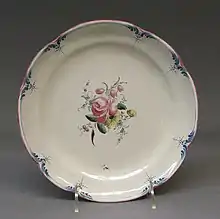Aprey Faience
Aprey Faïence is a name used for the painted, tin-glazed faience pottery produced at a glass-works at Aprey, France. This factory was established in 1744 by Jacques Lallemont de Villehaut, the Baron d'Aprey,[1] on his estate. In 1760 he partnered with his brother Joseph, and the two hired Protaix Pidoux, a Swiss pottery painter. Jacques withdrew from business in 1769, so Joseph hired François Ollivier, a potter. Ollivier became director from 1774–1792.[2] The factory came under the ownership of the Baron d'Anthès de Longpierre in 1789,[3] then closed in 1885.[2]
.jpg.webp)

The pottery produced at this factory were styled after early Strasbourg pieces, typically with decorations of birds or flowers.[4] The high quality of the work produced at this factory, along with the bird illustrations by the chief painter, made these pieces a preference of collectors. Early works did not have a distinct marking. Later pottery was of a lower quality, and these inferior pieces were typically marked with an A.P. symbol and the initials of the painter.[3]
References
| Wikimedia Commons has media related to Aprey faience. |
- Demmin, Auguste (1873). Guide de l'amateur de faiences et porcelaines (in French). 2. Librarie Renouard. pp. 707–708. Retrieved 2011-03-05.
- Campbell, Gordon (2006). The Grove encyclopedia of decorative arts. 1. Oxford University Press US. p. 24. ISBN 0-19-518948-5.
- Solon, Louis Marc Emmanuel; Burton, William (1903). A history and description of the old French faïence: with an account of the revival of faïence painting in France. Cassell and company, limited. pp. 125–126. Retrieved 2011-03-05.
- Berges, Ruth (1964). From gold to porcelain: the art of porcelain and faïence. T. Yoseloff. p. 74.
